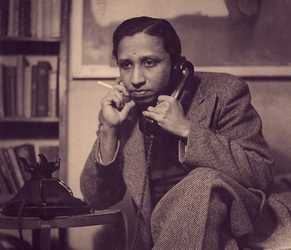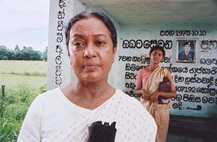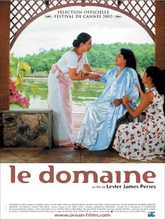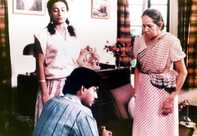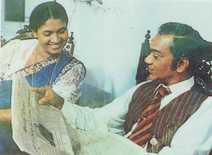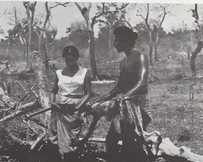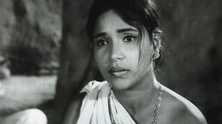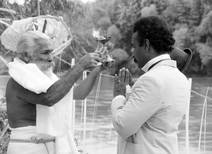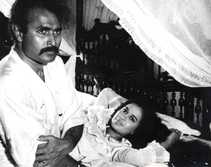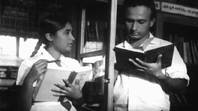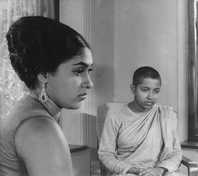|
[texte reproduit de Heliotrope Films]
Né le 5 avril 1919 à Colombo, dans une famille catholique, de père médecin, Lester James Peries a reçu une éducation religieuse dans un collège de novices. En 1938, il abandonne ses études pour se lancer dans l’écriture et le journalisme. Il écrit des pièces de théâtre, rédige des critiques de films dans le supplément culturel du Daily News et tient une chronique littéraire hebdomadaire à Radio Ceylan. En 1946, ses parents l’envoient rejoindre son frère Ivan à Londres, où il séjourne jusqu’en 1952. Il signe de nombreux courts-métrages où s'affirment les influences de Robert Bresson, Jean Renoir et Yasujirō Ozu. Il collabore également au journal The Times of Ceylon. À son retour à Colombo, il rejoint, en tant qu’assistant-réalisateur, le Government Film Unit, organisme d’État qui produit des programmes documentaires. En 1955, il démissionne et commence à travailler sur le premier long métrage en langue singhalaise tourné à Ceylan, Rēkhāva (La ligne du destin), avec l’opérateur William Blake et le monteur Titus De Silva. Modèle de réalisme social et de poésie, Rēkhāva est présenté au Festival de Cannes en 1957.
|
Son grand succès commercial et critique vient en 1963 avec Gamperaḷiya (Le Changement au village). Son œuvre va de la comédie sentimentale (Dǣsa nisā, Pour un certain regard) à l'illustration de textes religieux (The God King, Le Roi Dieu) en passant par la reconstitution historique (Saṁdēśaya, Le Message) ou le drame (Goḷu hadavata, Les silences du cœur, Akkara paha, Cinq Arpents de terre). Considéré comme le Satyajit Ray de Sri Lanka, la comparaison est flatteuse mais erronée, tant le cinéma de Peries est éloigné et même à l'opposé de celui du cinéaste bengali. Peries se définit comme un réaliste qui s'inspire de la philosophie bouddhiste. Cinéaste adulé dans son pays, il est présent dans tous les festivals, étant membre du jury à Cannes en 1992. À 84 ans, il fait un retour remarqué avec Vǣkanda valavva (Le Domaine), librement adapté de Tchékhov.
« Les longs métrages qu’il a réalisés à ce jour offrent une vue panoramique des divers aspects de la société srilankaise. À travers eux surgissent quatre thèmes principaux qui n’ont cessé de préoccuper Lester James Peries : le monde rural, la vie citadine qui s’y oppose, l’héritage historique et enfin le monde bouddhique. » ― Ananda Abeydeera, Inalco, extrait du texte de présentation de la rétrospective Lester et Sumitra Peries à la Cinémathèque française, février 1988.
J’ai toujours eu le sentiment que le domaine où le cinéma peut réussir parfaitement, c’est lorsqu’il capte les nuances des sentiments, les subtilités de l’émotion, parce que la caméra a la capacité d’être à l’écoute de la vie. On peut découvrir les émotions cachées et démêler la vie secrète de nos personnages. Et cela est assez important dans nos contrées orientales, où les gens ont tendance à masquer leurs sentiments et leurs émotions, ainsi que les questions essentielles de l’existence humaine. ― Lester James Peries (Positif, octobre 1980)
Lester James Peries is internationally recognized as one of the world's greatest film directors and considered the father of Sri Lankan cinema. He was born in 1919 in the then British colony of Ceylon, and started his career as a journalist. He became a film critic for the cultural Daily News supplement. He was a literature reviewer for Radio Ceylan. He had a pasionated interest for Tchekhov, he wrote plays and participated in "drama circle". In 1946, he went to England and work as a journalist for The Times of Ceylon. He also directed short films. Back in Colombo in 1952, he joined the Government Film Unit, a public documentaries production company.
His first feature film Rēkhāva (The Line of Destiny) was shown at the Cannes Film Festival. His first big success came in 1963 with the film Gamperaḷiya (Changes in the Village) and since then he has made about 20 feature films including Nidhānaya (The Treasure, 1970), and Kaliyugaya (Age of Darkness, 1983).
Read also :
- Lester James Peries obituary, The Guardian (30 April 2018)
- Lester James Peries, 99, visionary Sri Lankan filmmaker, dies, The New York Times (4 May 2018)
- Ceylon: Native Films Are Catching On, The New York Times (7 September 1970)


